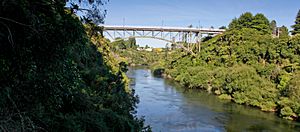Victoria Bridge, Cambridge, New Zealand facts for kids
Quick facts for kids Victoria Bridge |
|
|---|---|
 |
|
| Carries | Motor vehicles |
| Crosses | Waikato River |
| Owner | Waipa District Council |
| Heritage status | |
| Designated: | 21 September 1989 |
| Reference #: | 4159 |
| Preceded by | Fergusson Bridge |
| Followed by | The Narrows Bridge |
| Characteristics | |
| Total length | 141 metres (463 ft) |
| Height | 35.4 metres (116 ft) |
| History | |
| Construction begin | May 1907 |
| Opened | 21 December 1907 |
The Victoria Bridge (also known as the High-level bridge) is a cool, strong bridge in New Zealand. It connects the towns of Cambridge and Leamington by crossing over the mighty Waikato River. It's a special type of bridge called a hinged braced arch bridge.
Contents
How the Bridge Was Built
The Victoria Bridge is quite long, stretching 462 ft (141 m) (about 141 meters). Its main arch in the middle is 290 ft (88 m) long. The bridge is 17 ft (5.2 m) wide and was built using over 330 tons of steel and 20,000 rivets!
The government engineer, Peter Seton Hay, made the bridge even stronger than first planned. He added more steel and made the concrete pillars much bigger. These pillars were made from local materials like Te Kuiti limestone and Cambridge sand, along with imported cement.
Building the Arch
The bridge's arch has three special hinges. This design allowed builders to construct it by building out from each side of the river. They anchored the parts to the pillars until the arch was complete. Once finished, the anchors were loosened, and the hinges helped the arch carry the bridge's weight. This clever method meant they didn't need temporary supports from below, which could have been damaged by floods.
Some of the important people involved in building the bridge included James Edward Fulton, who changed the design to an arch, and John Alexander Low Waddell, who was a consultant. G. M. Fraser was the main contractor, and S. W. Jones was the engineer who worked on site.
Bridge History and Cost
The idea for the Victoria Bridge took several years to become real. In 1899, C W Hursthouse looked at different ideas for a bridge. In 1901, a meeting chose the spot where the bridge stands today.
The government agreed to help pay for the bridge after visits in 1902 and 1903 by Liberal MP, Sir Joseph Ward. The parts for the bridge were ordered from the American Bridge Company in March 1906 for £5,078. A year later, the building contract was given to G M Fraser for £5,692.
Grand Opening
Building started in May 1907, and the bridge officially opened on 21 December 1907. The Governor of New Zealand at the time, Lord Plunket, opened the bridge.
The total cost of the bridge was £13,814. The government paid £3,000, and the rest was shared by several local councils. These included Cambridge Borough Council, Pukekura Road Board, Piako County Council, Waipa County Council, and Waikato County Council.
Earlier Cambridge River Crossings
Before the Victoria Bridge, people crossed the Waikato River using a punt (a flat-bottomed boat).
First Bridges
The very first bridge was built in 1870-1871 by the armed police for £1,500. It was quite low to the water, with some of its support pillars in the river. Sadly, a big flood on 17 November 1875 destroyed it.
It was replaced by the Red Bridge in 1876. This was a wooden bridge, 143 feet long and 14 feet wide. It cost £2,345 and was built 12 feet higher than the first bridge. The Red Bridge became shaky over time, which led to the decision to build the stronger Victoria Bridge. The Red Bridge was taken down in 1909.

